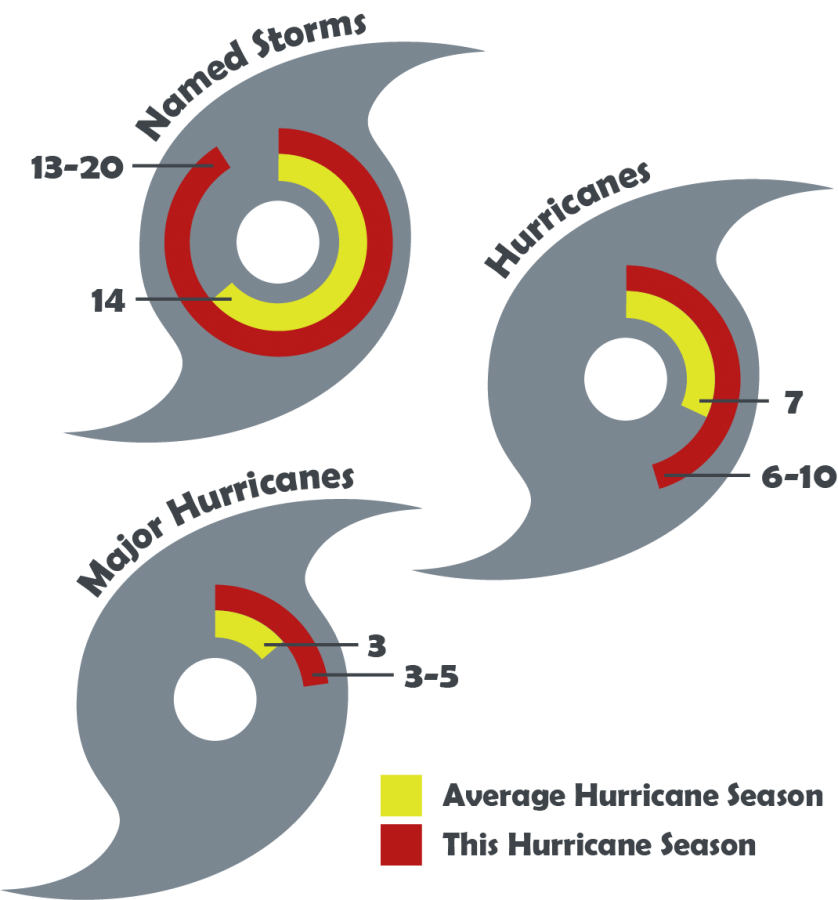On the 16th anniversary of Hurricane Katrina, one of the United States’ most costly and deadly hurricanes ever, Hurricane Ida battered the coast of Louisiana, becoming the fifth strongest hurricane in the entire country’s history. Over one million people were left without power, and many more suffered damage to their homes and personal health.
Hurricanes are becoming both increasingly deadly and frequent with each coming hurricane season. According to the National Oceanic and Atmospheric Administration (NOAA), the new statistical average Atlantic Hurricane Season used to compare each new season to has risen from 12 to 14 named storms and 6 to 7 hurricanes.
This trend can be measured using the Power Dissipation Index, which measures the storm intensity, frequency and duration, and provides a measure of total hurricane power over a hurricane season. Using this factor, the U.S. Global Change Research Program found that the PDI of the North Atlantic Ocean had a general upward trend starting in the year 1980 and continuing to the present.
The cause of this rise has largely been attributed to climate change, and more people are starting to study its specific effects.
“NOAA scientists have evaluated the impacts of climate change on tropical cyclones and determined that it can influence storm intensity,” Matt Rosencrans, seasonal hurricane forecaster at NOAA’s Climate Prediction Center said in a NOAA article interview.
Climate change impacts these storm systems by altering how they form and take shape. Science teacher Emily Massey-Burmeister explains how hurricanes form and how climate change and global warming plays a part in the process.
“Due to the warming of the oceans, the longer or the greater the depth of warm water that you have, the more hurricane fuel you have,” she said.
She also said that this warmer water could not only be fueling hurricane formation off the coast of Africa but also slowing down the currents in the ocean. The longer these currents stall out in the ocean, the greater the amount of warm water that builds up, which could potentially extend the time frame of hurricane season.
The UF Thompson Earth Systems Institute states research that supports the claim that ocean warming due to climate change does more than just harm people with deadly and more frequent hurricanes. Ocean circulation is an important function of the ocean that allows currents to flow both deep in the ocean and on the surface, affecting the movement of air and water throughout the world. When the water temperatures are warmer, the currents and ocean circulation becomes weaker, which slows down hurricanes and allows them to spend more time gathering intensity out at sea before impact.
As this large-scale impact continues as a revolving cycle, smaller scale communities and economies are being damaged with the tolls of increasing hurricanes. Massey-Burmeister explained the term “climate refugees” which refers to the people who have been forced to flee their communities as a result many different kinds of climate change, including hurricanes and other major storms.
“You’re having towns and cities and parts of the world that, potentially, are going to start losing a lot of citizens, and they’re going to start losing livelihoods,” Massey-Burmeister said.
On a more local level, the Trinity Prep campus often feels the impact of the volatile environment. Maintenance Director Luis Garcia is in charge of leading the preparations that Trinity has set in place for hurricanes and other types of major storms.
“Preparation is key, knowing who to call, and making sure that you have a good checklist,” Garcia said.
Some of these preparations included in his long checklist include securing all loose items that could be moved by weather, taking in all outdoor sports equipment and pumping down the water in the pool.
Garcia also said that having a campus surrounded by lakes makes it more susceptible to lightning and extreme rain, which can cause extra inconveniences around the school campus.
“The first thing that comes to mind is flooding,” Garcia said. “As you can tell, some areas on campus [like] the sidewalks become flooded, and it’s difficult to walk around them.”
Massey-Burmeister suggests that changes to the way we treat the environment could help alleviate the continuing danger of these natural disasters, but more countries around the world would have to join the cause to contribute to the shift.
“Change in terms of climate change is going to have to be relatively swift, and I think it has to be overarching,” Massey-Burmeister said.




